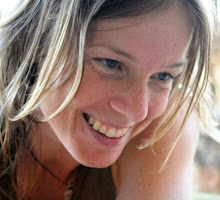Then it was time for my first encounter with the oily salt soup in the lowest place on Earth - The Dead Sea. Katina and her son Ishak from Sweden were my company and we started from Tivon around 8 in the morning. I read my Hebrew road map flawlessly and guided us past Afula and Beit She'an and further down through the Jordan valley, on road 90 straight through the West Bank. I had no clue how fast we would move down and I was very surprised when we suddenly were on the bypass road past Jericho. We had been sitting talking about this and that, watching the Jordan valley become progressively more desert-like, and the time had just passed very quickly, but I guess that I also had expected that it would be much longer than it really is. This is a phenomenon that a Swede living in Israel frequently encounter. In Sweden, driving Malmö-Stockholm with few or no breaks at all is done without blinking, and that is 200 km more than from Kiryat Shmona to Eilat - i.e. the whole of Israel, from North to South. There really are no long distances in this country and what sometimes makes a trip tedious is either heavy traffic or poor roads. Road 90 is however not burdened by heavy traffic ever since the First Intifada, when cars driving there was constantly bombarded with rocks. Thanking the stone bridage for the open road is maybe slightly cynical, but we glided down through the valley as a hot dog on a soaped hallway floor.

The classic Dead Sea floating picture
We decided to go to the Ein Gedi Spa. The entrance to all baths and muds, as well as a proper lunch, was only 100 ILS, which is less than 200 SEK. It proved to be very valuable. Since this spa was built, the water level has sunk dramatically, and today they have a small "chu chu train" that shuttles the guests from the main building down to the beach. The beach on this spot was not rocky, but rather only consisting of salt sand. However, as you went into the water, the bottom consisted of a hard mat of sharp salt crystals, so bathing shoes was necessary. Everybody who ever went into a salt lake know the surrealistic feeling of floating like a cork. You can relax completely and do nothing. If you try to turn around to do some breast-style swimming you will discover that your feet end up way too high above the water surface to be able to take you anywhere. Fascinating and fun! Just as pleasant as the floating is, as unpleasant is it if you happen to get the water in your eyes, nose or mouth. The salinity is fluctuating above 30% and 1 litre of sea water contains approximately 300 g of minerals and these concentrations are extremely painful to get into the wrong place.

The salt content in the Dead Sea water
After floating around for a while we found a mud hole down at the beach, where we took our first mud bath. This was not the "official" black mud, but rather a natural creek with a sandy greenish mud, also supposed to be beneficial. I dived down and completely indulged myself in the dirt, sliding around in the soft jelly, covering everything but my eyes and mouth. The minerals in the mud and the water is said to penetrate and detoxify the blood stream.

Two black mud aliens
When we returned up to the spa, we went to the black mud area and once again covered up. This mud was even finer and darker and was contained in huge jars. The place is filled with a constant laughter and people continuously assist each other taking pictures of their creations. Ishak took it one step further and simply jumped into the mud jar.

Ishak in the mud jar
We had lunch at the spa before we left for Masada. Nothing revolutionary, but generous considering the price. The restaurant reminds of a school dining hall and you go and pick up food yourself from a nice buffet. However, we ate outside in the garden which was a bit more scenic. Saturated with both minerals and food we headed off towards Masada. We arrived around 15 which gave us less than an hour on top since the last cart went down at 16. Anyhow, we felt quite satisfied with that. What disappointed me a bit though, was that we were not allowed to stay for the sunset. Only the sunrise is possible to watch from the top, so that will be saved for next visit.
We walked around and saw different chambers, bath tubs, old paintings and mosaic floors, but honestly, as far as I am concerned, I do not need to see every corner of the place to feel satisfied. A rock is still a rock, and a ruin a ruin. The place is also packed with tourists, of course, and this unfortunately withdraws most of the possibility of sensing some historic atmosphere. According to me, I feel safe to say that the view from Masada is what took my breath away, not so much the rock in itself. On the way down we visited the souvenir shop and was baffled by the prices. A Pashima shawl that you can get for 15 ILS in Daliyat al-Karmel, went here for 59 ILS. Amazing how stupid people are. After coming down from Masada we drove straight home. From Masada to Kiryat Tivon, including a short break, took about 3 hours. Not bad at all. Today I am sweating sulphur, but feel pure as a baby...

The Dead Sea valley seen from the Northern Palace on Masada






3 comments:
This is so funny - the family and I were staying at Ein Gedi kibbutz/guest house just before you - Sunday-Monday and enjoyed the same floating and wallowing in the mud! We have to save Masada for next time.
:) That is funny!
Maybe you are still in the country and also get to experience 50 gizillion mm Israeli rain and the visit from a very dramatic thunder God..?
We left early this morning, so I only got to see the wet streets at dawn...
I do understand the significance and wish you ore of it!
We will be back, before too long.
Post a Comment